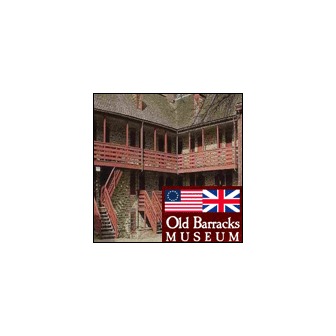Old Barracks Museum





In 1758, the Barracks was the biggest building in Trenton. About 300 British and Irish soldiers were the first to live here. The building was made of stone and had dark red woodwork. There were about 20 soldiers' rooms, each with two windows, a door and a fireplace. Twelve soldiers were housed in each room, with two men sleeping in each wooden bunk. The soldiers received rations of food, firewood, candles, cider, salt, and vinegar. There was a kitchen in the cellar, but most soldiers cooked in their rooms. In the center of the building was a little house with a staircase to the second floor and the balcony. The Officers' House was fancier and more comfortable. Cows, pigs, chickens and horses were kept outside in the yard. The first soldiers to occupy the Barracks were two companies of Irishmen, the Inniskillin's (1758-1759); two companies of lowland Scots, the First Regiment of Foot (1759-1760); and two companies of British soldiers with Swiss officers, the Royal American (1761-1762).
During the Summer of 1995, a major archaeological investigation of the Barracks' grounds provided some much-sought details about the local landscape in the 18th century. The excavations were conducted in preparation for the restoration of the Old Barracks and its site, which was completed in 1998.
A team of archaeologists, headed by Ian Burrow from the firm of Hunter Research, Inc. of Trenton, opened several exploratory trenches in the parade ground and on the perimeter of the South and West of the building. They were looking for the original surface level of the parade ground and evidence of the palisade, or barracks fence that surrounded the structure during the French and Indian War and the American Revolution.
The team removed topsoil in selected areas and discovered the original parade ground surface and post holes from the Barracks palisade fence. The foundations of 19th century buildings that faced Front Street and a roadway laid in 1792 that cut through the Barracks were uncovered. A trench was excavated through 16 feet of 19th and 20th century fill to the rear, or West, of the Barracks, where Petty's Run once flowed.
It was determined that the Barracks once stood on a rather steep escarpment immediately above the Run, which was a creek that powered a local forge and plating mill. Portions of the palisade fence were unearthed in the 18th century layer at the bottom of this trench.
Also uncovered was a 200 year old leather shoe, almost intact, a section of an adze-dressed post, and a number of barrel staves that were pulled from the mud that was once Petty's Run. A shoe buckle turned up in the same test pit as one of the barracks-fence post holes on the south side of the building. The soil between the foundations of the 19th century houses yielded evidence that pre-dated the Barracks, including pottery shards and a Lehigh broadspear point from Native American (Late Archaic/Early Woodland) occupation.
Overall, the landscape is remarkably different since soldiers first slept in the Barracks in 1759. Click below to see the current topography of the Barracks, and a very different topography from when the Barracks was first built.
Explore Related Categories







